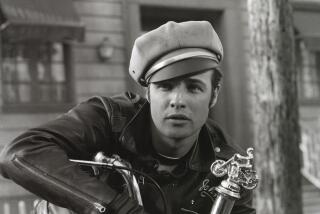Feedback: Let’s talk Marlon Brando
Marlon Brando in person
I worked as a plumber for a firm in Beverly Hills. I used to go up to Marlon’s house on Mulholland Drive to do jobs [“Another Side of a True Enigma,” July 26]. I always enjoyed working for him. He would follow me around as I worked and would talk. Talk about anything and everything. After my job was done, we would talk for hours. Always over glasses of Martinelli’s sparkling cider. He’d buy it by the case. A very generous man, but you could always sense the loneliness as you left.
Chris Byrn
Lomita
Read Marlon Brando’s autobiography from years ago. Was especially intrigued by the positive feedback he had for meditation. Did it help that much? It didn’t hurt because it helped with some anxieties he had, but in the long run it didn’t provide the kind of Rx to alleviate the chronic loneliness and sensitivity arising from the emotional scars created by rejecting parents.
I do think that “Last Tango in Paris” was his best film because he expressed a depth of vulnerability that’s been plumbed by few actors.
Mark Mandell
Sherman Oaks
Conversation from the stage
As I read Anna Deavere Smith’s continuing challenge for us all [“From the Stage, a Call to Action,” July 26] I am reminded about the word “conversation,” as it’s supposed to be more than one-sided. Too often, some of us attempt to engage family and friends in dialogue with the frustration of no engagement from the person you are trying to have a conversation with. Anna Deavere Smith does an amazing job of engaging the audience in the conversation.
Passing out tablets and pens for them to put down their thoughts is challenging and allows many to begin that dialogue, often with themselves. Many movie theaters could encourage such exchanges following a movie. “What did you think? How did the movie make you feel?” And assorted other questions that might lead to interesting dialogues. Why not try it?
I hope Anna Deavere Smith keeps on in this pursuit of deep and respectful engagement.
Beverly Franco
Monterey Park
The ‘Ragtime’ we almost had
Oliver Gettell’s July 26 piece on movie adaptations of E.L. Doctorow’s novels [“Film Was Rarely Kind to Doctorow”] doesn’t mention that Doctorow himself initially adapted “Ragtime” for the screen, with Robert Altman set to direct. The script, which is extraordinary, has been published. Following the disappointing box-office returns on his “Buffalo Bill and the Indians,” Altman was dropped by that film’s executive producer, Dino De Laurentiis, and replaced by Milos Forman, who used an entirely new screenplay by Michael Weller.
Forman’s movie has its felicities, but the Altman/Doctorow project must surely take its place among the greatest movies never made.
Peter Rainer
Los Angeles
Film critic, Christian Science Monitor
Coates limited by race focus?
So I guess I’m just another hater white guy. But Ta-Nehisi Coates’ entire existence seems to be about being black [“Being Black in the USA,” July 26]. How can this fill his being? Physics, love, the earth, whatever, there is an entire planet out there to talk about. I know this is his gig, but it’s so sad that this is it for him. Mr. Coates, man, you bore me.
It’s sick to talk about race all the time. It’s divisive and ancient and tribal. Your world is far too small for me, brother. It’s funny, you know, Neil deGrasse Tyson does far more for your cause then than you will ever do. And he never mentions race. You divide. He joins.
One last thing. Saying things like the “special love black people have for their children” is the talk of a fool.
Scott Paterson
Redondo Beach
The other side of ‘Nagasaki’
As a WWII Navy officer in the South Pacific, I take great exception to Louise Steinman’s review of the book “Nagasaki” by Susan Southard [“After the Bomb Dropped,” July 26]. After 70 years, the author and reviewer are still complaining about the tragic deaths and disfigurements of the Japanese civilians as a result of the second bomb. Were these worse than the deaths at Hiroshima, or in Tokyo, Nagasaki and Kobe, which had been fire-bombed with 1million casualties and total destruction on the ground?
The reviewer recites the old “chestnut” about the Japanese warlords being “...on the verge of surrendering.” If they were on that verge, they could have done so after our capture of Iwo Jima and Okinawa, when it should have been obvious that they were doomed to defeat. Instead, they were digging trenches and constructing fortifications on the beaches of Kyushu and Honshu, awaiting the arrival of U.S. landing boats with our 1million troops. They had another 1,000 or so kamikaze planes ready to pounce on our fleet.
We learned from all our missions to recapture the various islands that the Japanese were not allowed to surrender; the same would have been true before the second A-bomb.
By the way, while the Japanese were “on the verge” of surrendering, hundreds of our POWs in Japanese prison camps, in Japan and elsewhere, were dying every day of starvation and torture. Those lives count as much, or more, than the Nagasaki casualties.
Robert Green
Northridge
‘Valley Fever’ is just the cure
What a fabulous read [“Finding Fiction Among Grapes,” July 26]! I just finished “Valley Fever.” With the ever-expanding interest in grapes, combined with the drought and talk of a bullet train through the Central Valley, this is a must read for Californians. If you like Joan Didion, you’ll love this.
Laura Main
Los Angeles
More to Read
The biggest entertainment stories
Get our big stories about Hollywood, film, television, music, arts, culture and more right in your inbox as soon as they publish.
You may occasionally receive promotional content from the Los Angeles Times.






